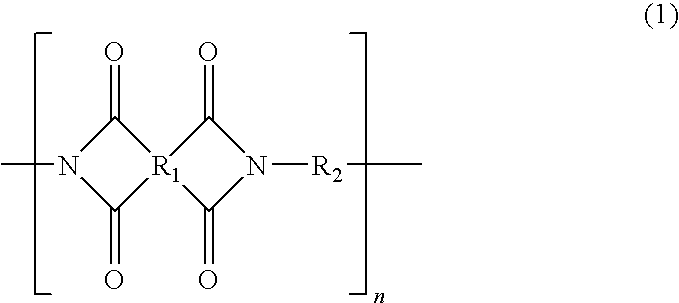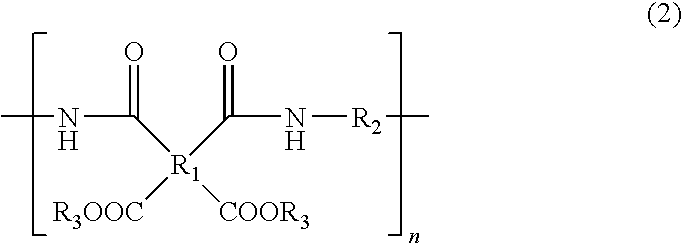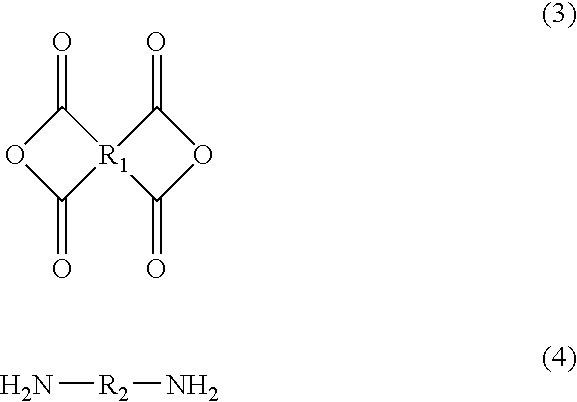Laminate having peelability and production method therefor
- Summary
- Abstract
- Description
- Claims
- Application Information
AI Technical Summary
Benefits of technology
Problems solved by technology
Method used
Image
Examples
example 1
[0101]A 50-μm thick non-thermoplastic polyimide film (UPIREX-50S available from Ube Industries, Ltd., and hereinafter referred to simply as “PI film”) was used as a heat resistant base, and a 0.2-μm thick copper layer was formed as a metal layer (I) on one surface of the film by sputtering. In turn, a 1.8-μm thick copper layer was formed as a metal layer (II) on the sputtered copper layer by electrolytic copper plating. Thus, a metal conductor layer of copper having a total thickness of 2.0 μm was formed. The polyimide precursor solution (A) was uniformly applied onto the metal conductor layer by a comma coater, and then dried at 140° C. until the viscosity of the solution was lost. The polyimide precursor was heated to 350° C. in a nitrogen gas atmosphere in an oven to be thereby cured into a polyimide. Thus, a 25-μm thick insulative film layer was formed. The glass transition of the insulative film layer was not observed at a temperature up to 350° C. as measured by DSC measuremen...
example 2
[0102]The polyimide film serving as the heat resistant base was peeled off from the laminate obtained in Example 1. At this time, the peel strength at the peel interface was measured to be 0.08 kN / m. The peeling was easily achieved. As a result, a 27-μm thick substrate (one-sided plate) for a flexible printed wiring board was produced, which included the metal conductor layer of copper and the insulative film layer of the non-thermoplastic polyimide resin.
example 3
[0103]A 50-μm thick polyimide film (UPIREX-50S available from Ube Industries, Ltd.) was used as a heat resistant base, and a 0.2-μm thick copper layer was formed as a metal layer (I) on one surface of the polyimide film by sputtering. In turn, a 1.8-μm thick copper layer was formed as a metal layer (II) on the sputtered copper layer by electrolytic copper plating. The copper layers thus formed had a total thickness of 2.0 μm. Further, a 0.15-μm thick layer of a nickel-chromium alloy (a mass ratio of Ni / Cr=90 / 10) was formed on the copper layers for prevention of rust. The polyimide precursor solution (B) was applied on the metal conductor layer thus formed.
[0104]A 9-μm thick insulative film layer was formed in substantially the same manner as in Example 1 except for the aforementioned point. The glass transmission of the insulative film layer was not observed at a temperature up to 350° C. as measured by DSC measurement. It was possible to properly handle the resulting laminate witho...
PUM
| Property | Measurement | Unit |
|---|---|---|
| Thickness | aaaaa | aaaaa |
| Thickness | aaaaa | aaaaa |
| Peel strength | aaaaa | aaaaa |
Abstract
Description
Claims
Application Information
 Login to View More
Login to View More - Generate Ideas
- Intellectual Property
- Life Sciences
- Materials
- Tech Scout
- Unparalleled Data Quality
- Higher Quality Content
- 60% Fewer Hallucinations
Browse by: Latest US Patents, China's latest patents, Technical Efficacy Thesaurus, Application Domain, Technology Topic, Popular Technical Reports.
© 2025 PatSnap. All rights reserved.Legal|Privacy policy|Modern Slavery Act Transparency Statement|Sitemap|About US| Contact US: help@patsnap.com



